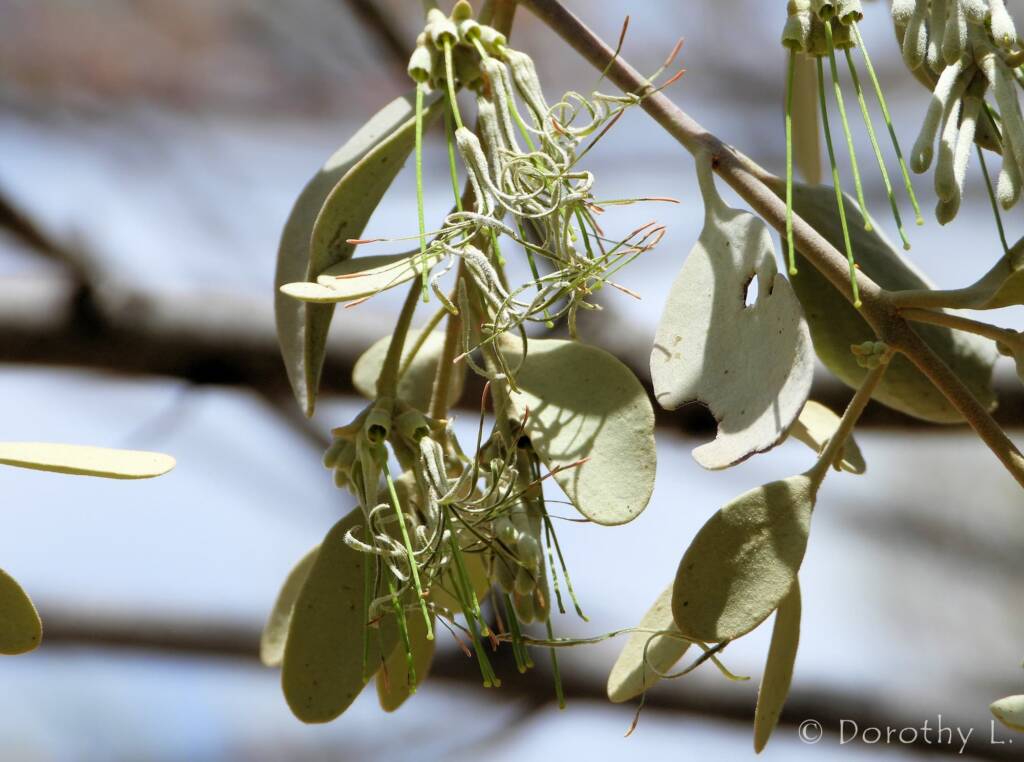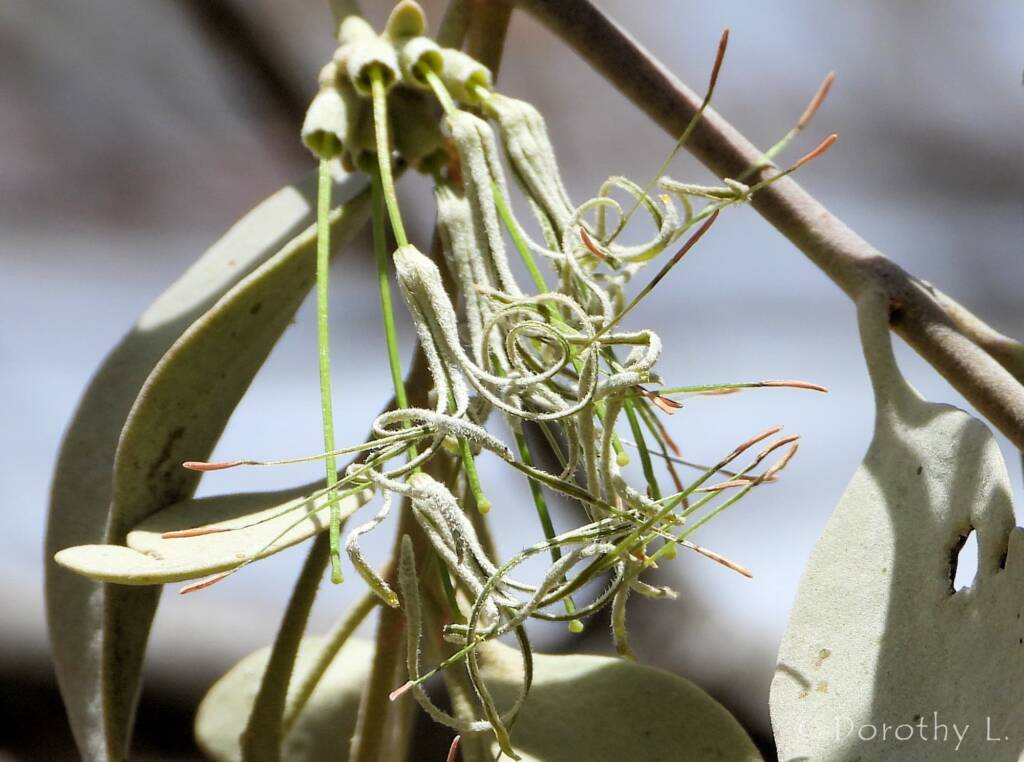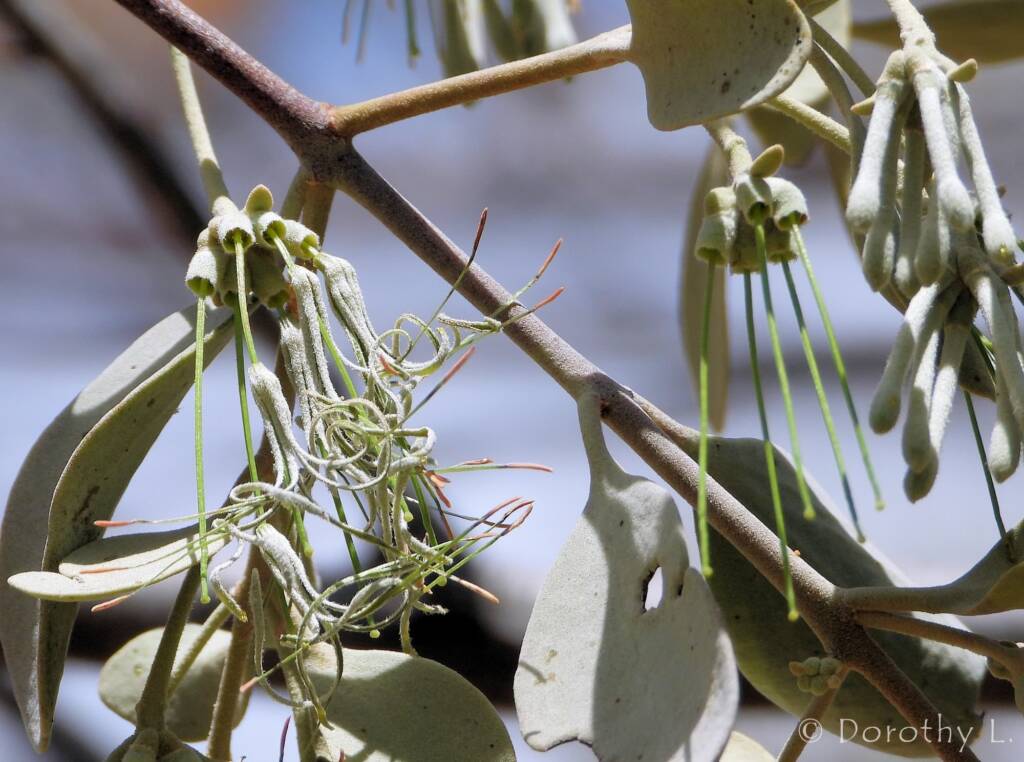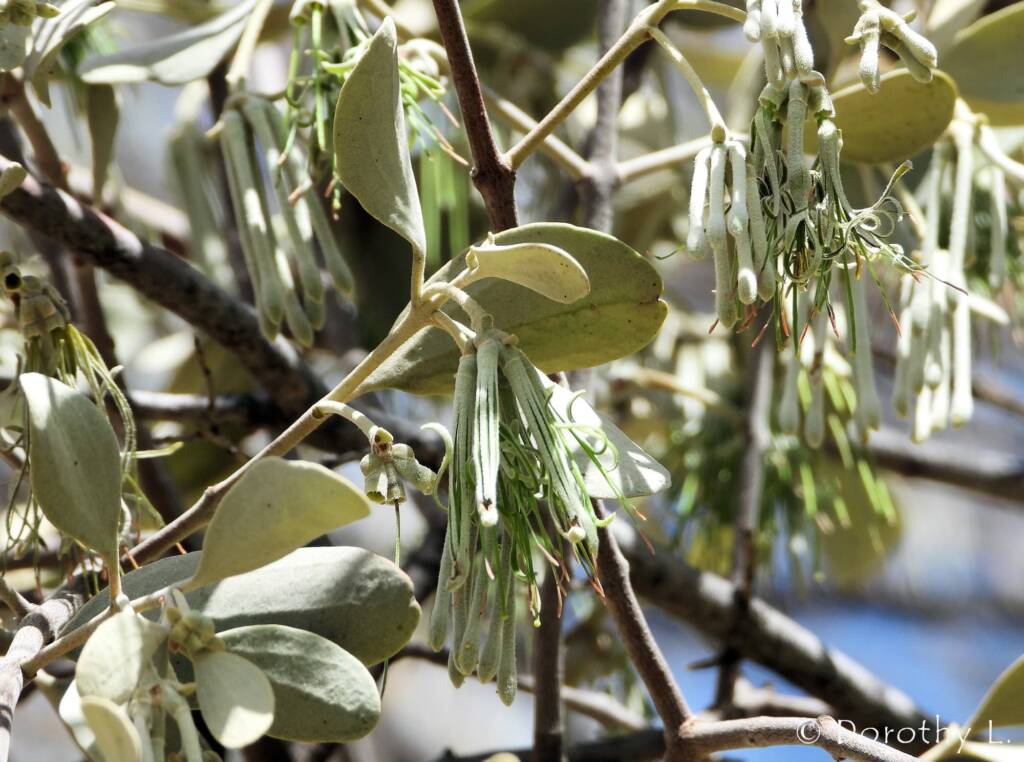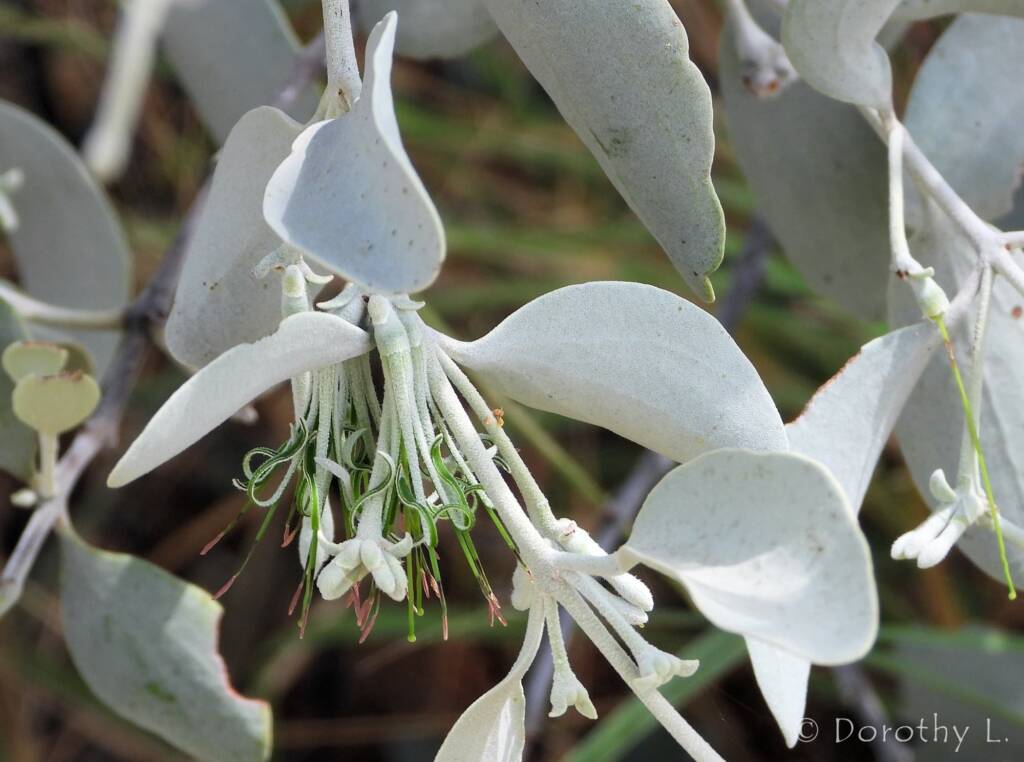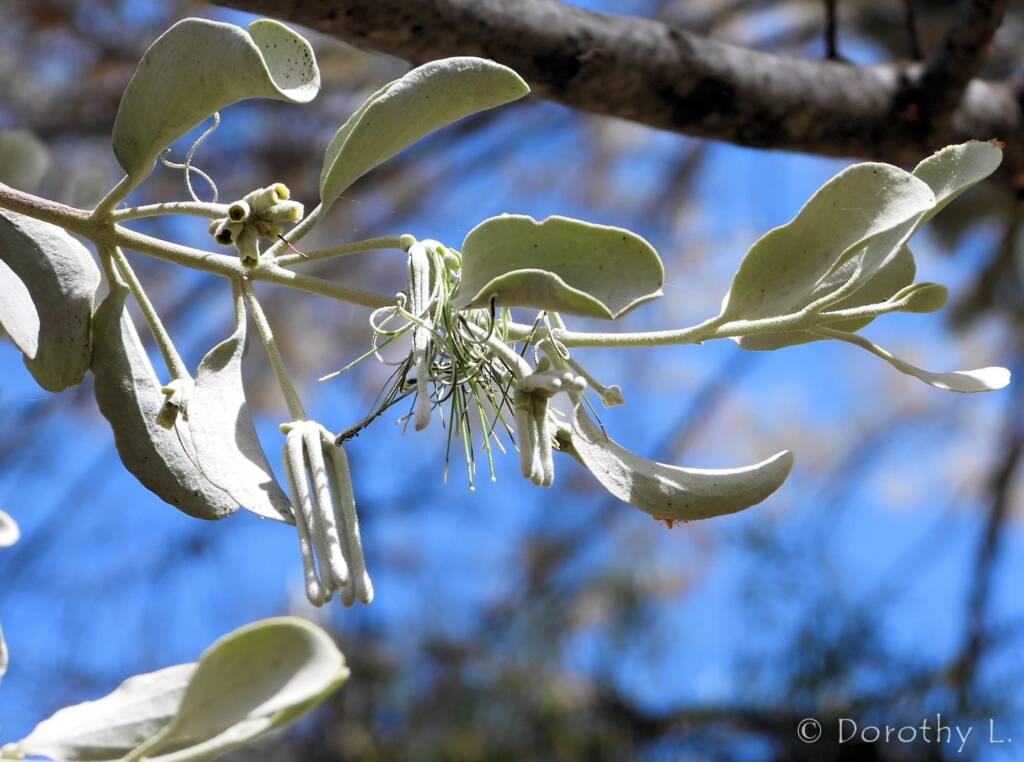Mistletoe FamilyHarlequin Mistletoe Pale-leaf Mistletoe Harlequin Mistletoe Yellow Form Wire-Leaf Mistletoe
Amyema madidenii is found across Australia, but not in Tasmania and rare in Victoria. They are especially common through Central Australia. This Broad-leaf Mistletoe (also spelt Broad-leaved Mistletoe, has a pale colour, hence it’s other common name of Pale-leaf Mistletoe (Pale-leaved Mistletoe).
There are 2 subspecies, Amyema maidenii subsp. maidenii and Amyema maidenii subsp. angustifolia.
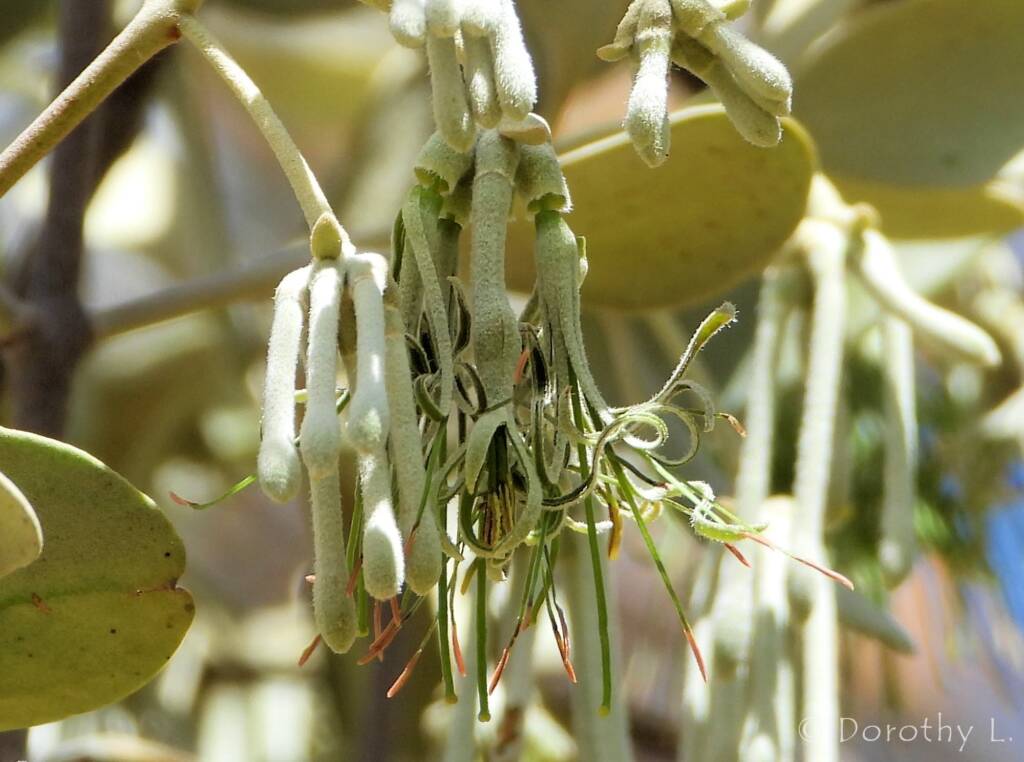
The leaves are pale and flat, and the florescence of this mistletoe is composed of two opposite triads, with all the flowers being sessile, attached directly by its base without a stalk or peduncle (the peduncle is the stalk of a flower also known as an inflorescence).
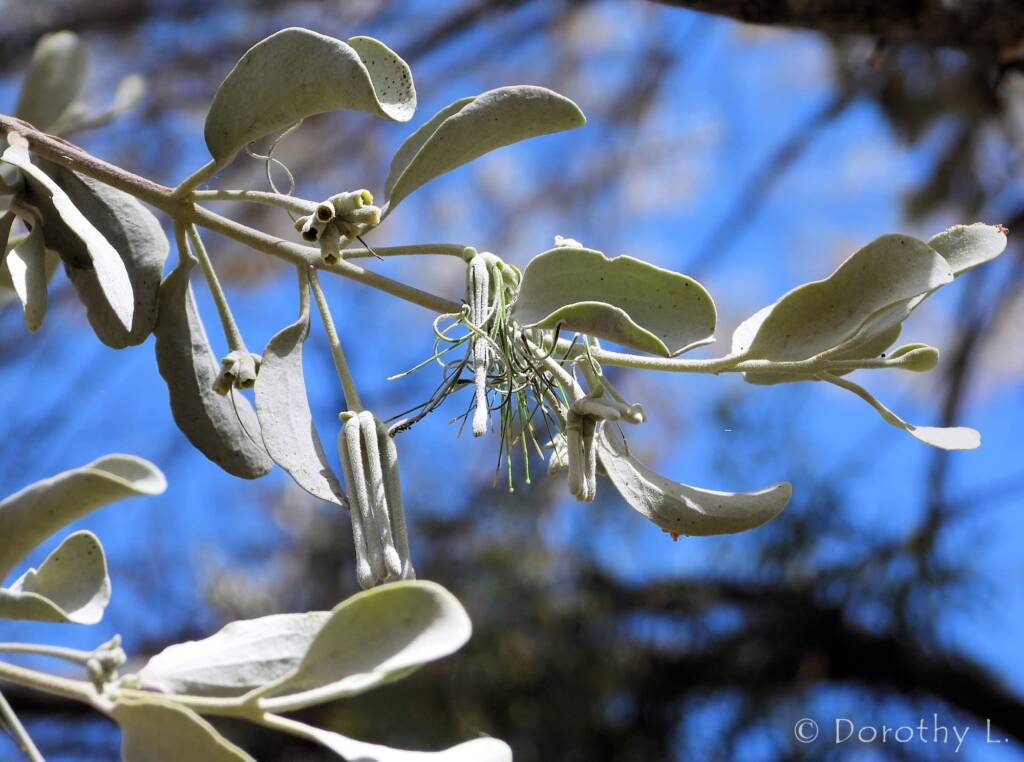
This species of mistletoe occurs in acacia shrubland and woodland understorey, that include a number of Acacia species such as Mulga, Brigalow and Witchetty Bush.
The berries of the mistletoe are eaten by a variety of birds and other fauna. Did you know that the berries of the mistletoe are called “snotty gobbles”.
A document on the AWS site “Can the Absence of the Dingo Lead to a Significant Transformation of Arid Vegetation?” by Nicholas Chu, who was the 2018 Australian Wildlife Society scholarship recipient University of New South Wales Wildlife Ecology Research includes a component about “that mistletoes create a cooler understorey microclimate and that red kangaroos preferentially rest beneath trees where mistletoes are present, when compared to where mistletoes are removed“.5
Another study by Jeffery Neil Foulkes investigated one of the preferred foods of the common brushtail possum (Trichosurus vulpecula) as being “species included Amyema maidenii leaves (a mistletoe)”.6
Images © Dorothy Latimer
- Scientific classification
- Kingdom: Plantae
- Clade: Tracheophytes
- Clade: Angiosperms
- Clade: Eudicots
- Order: Santalales
- Family: Loranthaceae
- Genus: Amyema
- Species: A. maidenii
- Binomial name: Amyema maidenii

Footnote & References
- Amyema maidenii (Blakely) Barlow, Atlas of Living Australia, https://bie.ala.org.au/species/https://id.biodiversity.org.au/taxon/apni/51299797
- Amyema maidenii, https://en.wikipedia.org/wiki/Amyema_maidenii (last visited Mar. 26, 2022)
- Amyema maidenii (Blakely) Barlow, Australian Parasitic Plants – Loranthaceae, North Queensland Plants, http://www.northqueenslandplants.com/Australian%20Plant%20Families%20G-M/Loranthaceae/Amyema/Amyema%20maidenii.html
- Amyema maidenii, Electronic Flora of South Australia species Fact Sheet, http://www.flora.sa.gov.au/cgi-bin/speciesfacts_display.cgi?genus=Amyema&species=maidenii
- Can the Absence of the Dingo Lead to a Significant Transformation of Arid Vegetation? by Nicholas Chu, University of New South Wales School of Biological, Earth and Environmental Sciences, Australian Wildlife Society, https://www.aws.org.au/wp-content/uploads/2021/01/AWS_Dingo_Article.pdf
- The ecology and management of the common brushtail possum Trichosurus vulpecula in Central Australia, by Jeffery Neil Foulkes, University of Canberra, https://researchprofiles.canberra.edu.au/en/studentTheses/the-ecology-and-management-of-the-common-brushtail-possum-trichos
- Snotty Gobbles, Nature Notes, Junior Ranger, Written by Stuart Traynor and illustrated by Bob Whiteford and Adi Dunlop, https://nt.gov.au/__data/assets/pdf_file/0005/200021/mistletoe.pdf
Mistletoe FamilyHarlequin Mistletoe Pale-leaf Mistletoe Harlequin Mistletoe Yellow Form Wire-Leaf Mistletoe
FloraFlora in Australia Flora Index Acacia Anigozanthos (Kangaroo Paws) Annual Yellowtop Apium prostratum subsp. prostratum var filiforme Apple Bush (Pterocaulon sphacelatum) Australian Bluebell Australian Gossypium Banksia Batswing Coral Tree Billy Buttons Birdsville Indigo Blue Pincushion Bush Banana Callistemon Callitris drummondii (Drummond’s Cypress Pine) Calothamnus quadrifidus Cape Honeysuckle Cassia fistula (Golden Shower) Cattle Bush Common Heath Crotalaria Darwinia wittwerorum (Wittwer’s Mountain Bell) Daviesia oppositifolia (Rattle-pea) Desert Oaks Drumsticks Eremophila Eucalyptus Ficus Flannel Cudweed (Actinobole uliginosum) Georges Indigo Goatshead Burr (Sclerolaena bicornis) Golden Everlasting Goodenia Gossypium Grass and Grasses Grass Trees Grevillea Grey Germander Hakea Kapok Bush (Aerva javanica) Lambertia sp Leptospermum MacDonnell Ranges Cycad Maireana scleroptera Mexican Poppy Minnie Daisy Mistletoe Family Nardoo Native Apricot Nicotiana megalosiphon subspecies sessilifolia Nuytsia floribunda Orange Spade Flower Orchidaceae Parakeelyas (Calandrinia) Pebble Bush (Stylobasium spathulatum) Perennial Yellow Top Pink Everlasting Pink Rock Wort Poached Egg Daisy Portulaca Proteaceae Ptilotus Quandong Resurrection Fern Rosy Dock Ruby Saltbush Santalum Solanum Spike Centaury Spinifex Storkbill (Erodum cygnorum) Striped Mint Bush Sturt’s Desert Pea Sturt’s Desert Rose Tall Saltbush Tangled Leschenaultia Tar Vine Tribulus eichlerianus Upside-down Plant Urodon dasyphylla Variable Daisy Waratah (Telopea) Wertabona Daisy White Cedar (Melia azedarach) White Indigo White Paper Daisy Wild Passionfruit Wild Stock Woolly-Headed Burr Daisy Woolly Bush Yellow-keeled Swainsona

